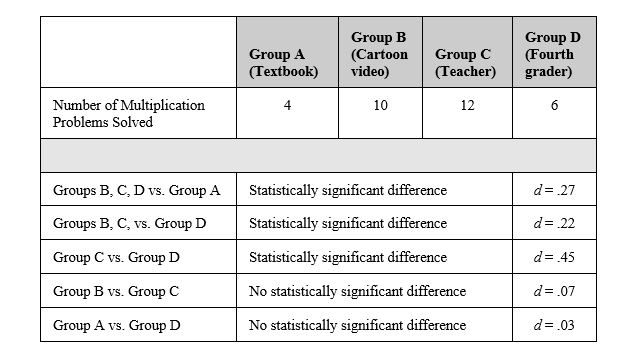RESEARCH STUDY 9.3
Dr. Phillips is a cognitive-developmental psychologist who studies how children learn mathematical principles. His current interest is in studying how children learn multiplication. He recruits 54 second graders who have not yet learned how to multiply numbers to participate in his study. He is curious as to whether different teaching styles lead to better mastery of the subject. One condition (A) involves having students read a chapter on multiplication from their textbook. One condition (B) involves having students watch a video of cartoon characters explaining multiplication. One condition (C) involves having students being taught multiplication from a teacher. One condition (D) involves having students being taught multiplication by a fourth grader. In all conditions, participants spend 30 minutes learning the fundamentals of multiplication and are then given the same 15-question multiplication test. The number of questions answered correctly is recorded. The data are below.

-Refer to Research Study 9.3 above to answer the following question.
Explain why Dr.Phillips cannot conduct a within-groups design.
Correct Answer:
Verified
View Answer
Unlock this answer now
Get Access to more Verified Answers free of charge
Q40: Order effects can be controlled by using
Q41: RESEARCH STUDY 9.3
Dr. Phillips is a cognitive-developmental
Q42: What is the difference between a posttest-only
Q43: What type of experimental designs is affected
Q44: RESEARCH STUDY 9.3
Dr. Phillips is a cognitive-developmental
Q57: What is a design confound? What type
Q61: Name three disadvantages of within-groups designs.
Q63: Explain the difference between full counterbalancing and
Q64: Define manipulation checks and pilot studies, and
Q65: Name three advantages of within-groups designs.
Unlock this Answer For Free Now!
View this answer and more for free by performing one of the following actions

Scan the QR code to install the App and get 2 free unlocks

Unlock quizzes for free by uploading documents